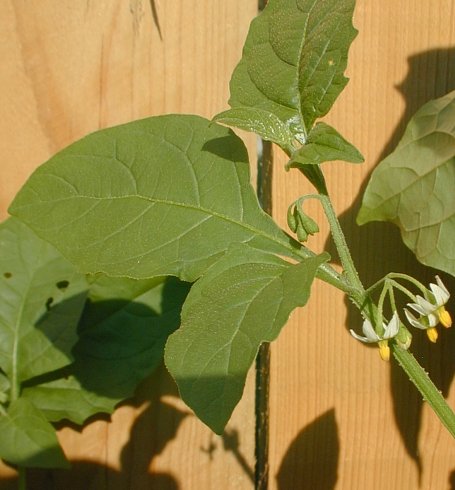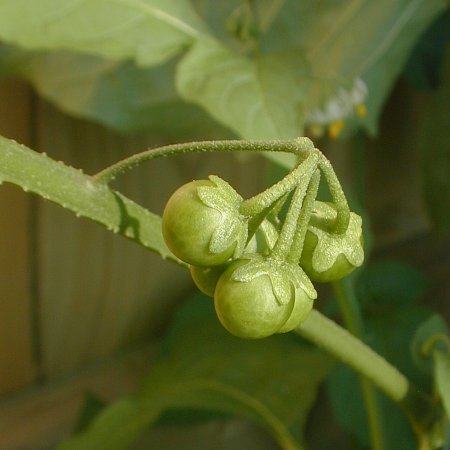Black Nightshade (Solanum americanum Miller) Different authorities provide differing accounts of the origination of Black Nightshade: Some claim it is a native species with a worldwide distribution, while others believe that it entered the United States from Europe or South America.
Nightshade cause some of the most serious weed related problems in Pacific Northwest agriculture.The most common members of this family found in PNW cropland are the annuals hairy nightshade (Solanum physalifolium Rusby, formerly S. sarrachoides Sendtner), black nightshade (S. nigrum L.),and cutleaf nightshade.
Cutleaf nightshade, however, is native to the dry regions and has become a serious weed problem in many dryland crop production areas in the PNW.
Crop Damage: Although light infestations of nightshades do not usually cause serious yield losses, heavy infestations will compete with the crop plants for available light, moisture, and soil nutrients. Nightshades can cause serious problems during harvest of several crops, such as green peas and snap beans. The nightshades do not dry as rapidly as many crop plants and are not killed by light frosts in the fall. Heavy nightshade infestations in potato fields may prolong harvest, especially if the potatoes have not been defoliated. Nightshades are also hosts for many plant pests (such as Colorado potato beetle and the late blight fungus) and may cause insect, disease, and nematode problems to increase in potatoes and other rotation crops.
Nightshade is more common in sites with a history of disturbance. Hairy nightshade and black nightshade look very similar. Nightshade should be correctly identified because some herbicides that effectively control black nightshade are less effective on hairy nightshade. Both cause considerable harvest problems. Hairy nightshade plants appear more upright than black nightshade and the leaves are covered with fine hairs which give the leaf a silvery gray color and may be “sticky” to the touch. Hairy nightshade berries remain green and do not turn purple. Black nightshade is a low-branching annual, 1 to 2 feet tall with triangular stems that bear oval, thin-textured, alternate leaves. The foliage of Black Nightshade  is green or dark green. Nightshade seed germination occurs in June through September and is influenced strongly by moisture. Hairy nightshade germinating in early fall may produce viable seed before frost while a black nightshade plant requires a longer growing season. A single plant may produce flowers sporadically for about 2 months. Each flower is replaced by a small round berry about 1/3″ across. The berry has a smooth surface that is initially green, but later becomes black as it matures. This berry is juicy and contains several flat seeds that are yellow or brown. Nightshade seeds become viable shortly after production and can remain viable in the soil beyond 10 years. The root system consists of a slender taproot that branch frequently. This plant spreads by reseeding itself. Nightshades are frost tolerant and stay green into the harvest season.
is green or dark green. Nightshade seed germination occurs in June through September and is influenced strongly by moisture. Hairy nightshade germinating in early fall may produce viable seed before frost while a black nightshade plant requires a longer growing season. A single plant may produce flowers sporadically for about 2 months. Each flower is replaced by a small round berry about 1/3″ across. The berry has a smooth surface that is initially green, but later becomes black as it matures. This berry is juicy and contains several flat seeds that are yellow or brown. Nightshade seeds become viable shortly after production and can remain viable in the soil beyond 10 years. The root system consists of a slender taproot that branch frequently. This plant spreads by reseeding itself. Nightshades are frost tolerant and stay green into the harvest season.
The caterpillars of the moth Heliothis subflexus feed on this plant, as well as other members of the Nightshade family. The small black berries are eaten primarily by birds, which includes the following: Wood Duck, Sora Rail, Ring-Necked Pheasant,  Wild Turkey, Cardinal, Catbird, Eastern Meadowlark, and Swamp Sparrow. These birds help to distribute the seeds far and wide. Mammalian herbivores avoid this plant because the foliage contains the toxic alkaloid, solanine. The plant may be a contaminant in hay, where it will still cause toxicity. Pets may eat the green, red, or black berries and be poisoned. The major toxin is solanine, an alkaloidal glycoside.
Wild Turkey, Cardinal, Catbird, Eastern Meadowlark, and Swamp Sparrow. These birds help to distribute the seeds far and wide. Mammalian herbivores avoid this plant because the foliage contains the toxic alkaloid, solanine. The plant may be a contaminant in hay, where it will still cause toxicity. Pets may eat the green, red, or black berries and be poisoned. The major toxin is solanine, an alkaloidal glycoside.
Toxicity: Moderate. While the plant itself is very toxic, it is also unpalatable, and rarely does an animal consume enough to cause a serious or potentially lethal poisoning. Toxic risk is higher if the plant is included in processed feeds. All animals, including pets, may be affected. All parts are potentially toxic; some believe the berries are often higher in toxicity.
Symptoms: Nightshade plants cause problems with the gastrointestinal tract and can also affect the central nervous system. Signs can include abdominal pain, vomiting, diarrhea, lack of coordination, weakness, depression, hallucinations, convulsions, and possible death.
Gastrointestinal signs can include: vomiting (in those species that can vomit), poor appetite, abdominal pain, and diarrhea which may become bloody. Central nervous system signs can include depression, difficulty breathing, lack of coordination, weakness, collapse, convulsions and possible death. In one report, one to ten pounds of plant material was potentially lethal for a horse.
A chronic toxicity has also been reported, where the animal eats small amounts of the plants each day. These animals tend to lack energy, show depressive symptoms or get intestinal problems.
Medicinal Uses: This species has the reputation of being very poisonous, however this is disputed by other resources. The toxin solanine, of which the nightshades are comprised of, vary in concentration throughout the season.
The berries are injurious to children, but are often eaten by adults with impunity, especially when quite ripe, as the poisonous principle is chiefly associated with all green parts. Cattle will not eat the plant and sheep rarely touch it.
In Bohemia the leaves are placed in the cradles of infants to promote sleep. In the islands of Bourbon and Mauritius, the leaves are eaten in place of spinach: and the fruit is said to be eaten without inconvenience by soldiers stationed in British Kaffraria.
It has been found useful in cutaneous disorders, but its action is variable, and it is considered a somewhat dangerous remedy except in very small doses.
The bruised fresh leaves, used externally, are said to ease pain and abate inflammation, and the Arabs apply them to burns and ulcers. Their juice has been used for ringworm, gout and earache, and mixed with vinegar, is said to be good as a gargle and mouthwash.
Besides the above-mentioned species, others are used for medicinal, alimentary, and other purposes. Some are employed almost universally as narcotics to allay pain, etc.; others are sudorific and purgative. Solanum toxicarium is used as a poison by the natives of Cayenne. S. pseudo-quina is esteemed as a valuable febrifuge in Brazil. Among those used for food, are S. Album and S. Æthiopicum, the fruits of which are used in China and Japan. Those of S. Anguivi are eaten in Madagascar. S. esculentum and its varieties furnish the fruits known as Aubergines or Brinjals, which are highly esteemed in France, and may sometimes be met with in English markets; they are of the size and form of a goose’s egg and usually of a rich purple colour. The Egg-plant, which has white berries, is only a variety of this. The Peruvians eat the fruits of S. muricatum and S. quitoense; those of S. ramosum are eaten as a vegetable in the West Indies. The Tasmanian Kangaroo Apple is the fruit of S. laciniatum; unless fully ripe this is said to be acrid. In Gippsland, Australia, the natives eat the fruits of S. vescum, which, like the preceding, is not agreeable till fully ripe, when it is said to resemble in form and flavour the fruits of Physalis peruviana. Of other species the leaves are eaten; as those of S. oleraceum in the West Indies and Fiji Islands.
Other species are used as dyes. S. indigoferum, in Brazil, cultivated for indigo. The juice of the fruit of S. gnaphalioides is said to be used to tint the cheeks of the Peruvian ladies, while their sisters of the Canary Isles employ similarly the fruits of S. vespertilia. The fruits of S. saponaceum are used in Peru to whiten linen in place of soap. S. marginatum is used in Abyssinia for tanning leather.
Control
Chemical: Nightshades are tolerant to many commonly used herbicides, including sulfonylurea herbicides. These herbicides control other broadleaf weeds and allow nightshade to increase by removing competition from other plants. Residual herbicides are required to control continuous flushes that are possible. Successful nightshade control requires allowing no seed production. Many chemicals can be used for control of nightshade in crop production. Consult the extension office or the PNW Weed Management Handbook for information on the control of nightshade in cropping systems.
Biological: Over 100 insects are being screened, however none have been effective for nightshade control so far.
More information can be found in the PNW Weed Management Handbook.
Use pesticides with care. Apply them only to plants, animals, or sites listed on the label. When mixing and applying pesticides, follow all label precautions to protect yourself and others around you. It is a violation of the law to disregard label directions. Store pesticides in their original containers and keep them out of the reach of children, pets, and livestock.
Photo credits included in pdf